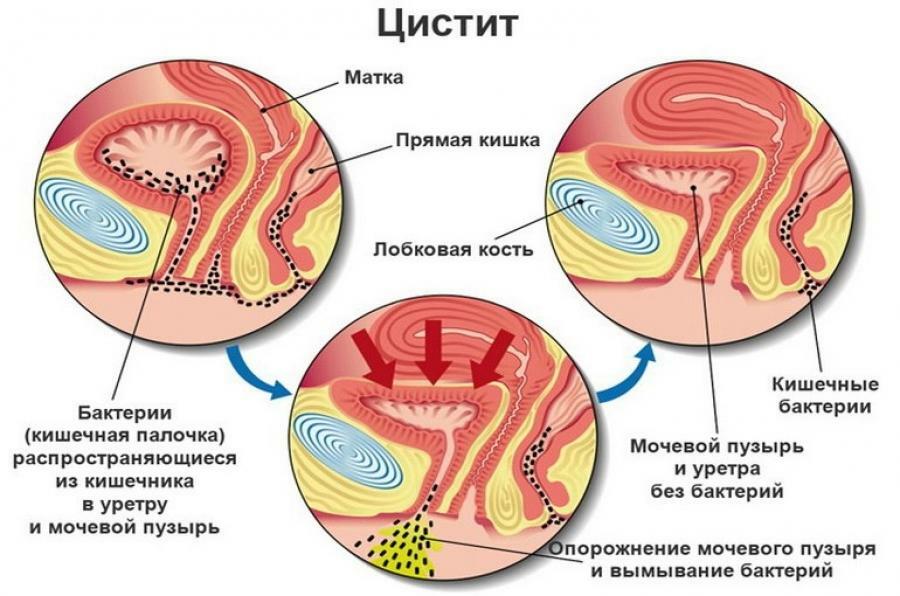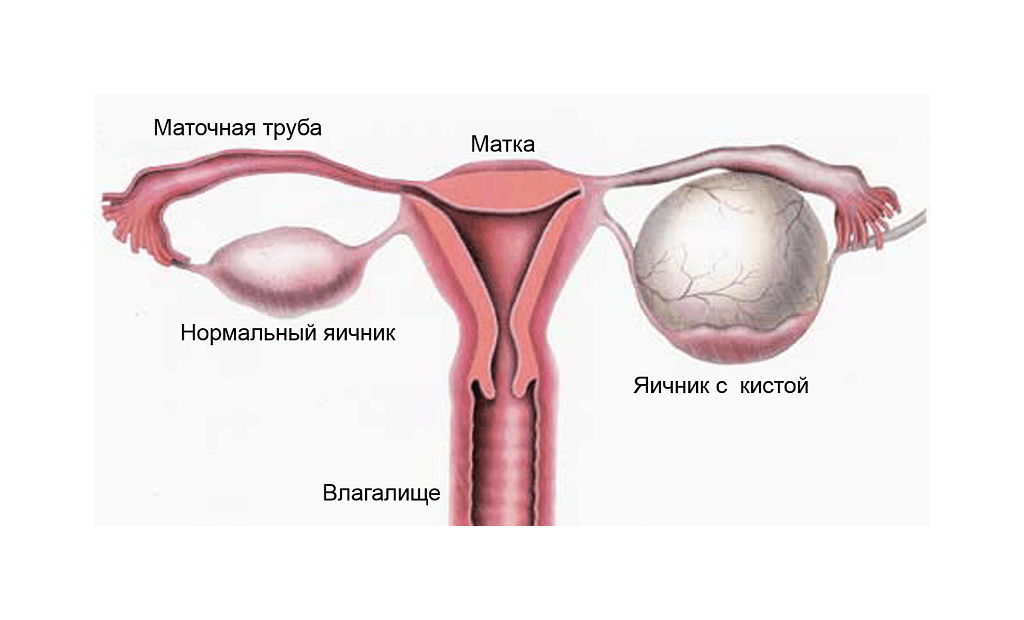Adenoids have long been considered a "childhood illness".However, in adults such a problem arises not less often, and its consequences can be extremely serious. Timely appeal to a specialist will get rid of the troubles associated with adenoids.

Adenoids in Adults: Symptoms
material Content
- 1 What adenoids
- 2 Symptoms adenoids adult
- 3 risk groups
- 4 What inspections have to go
- 5 treatment without surgery
- 6 Surgery to remove the adenoids
- 7 Methods adenoidectomy
- 7.1 Video - Removing the adenoids
- 8 rehabilitation period
What are adenoids
Adenoids - folds of lymphoid tissue - arise when the nasopharyngeal tonsil begins to grow. Until the child is 5-7 years old, it works as the main filter on the path of infections to the respiratory and gastrointestinal tract. Then this function is adopted by the palatine tonsils, and the nasopharyngeal tonsil dies off by 14-16 years.
That's interesting!
Adenoid tissue was thought to be absent in adults. However, the appearance of endoscopic equipment disproved this opinion. Every third adult who complains of shortness of breath, the disease is provoked by adenoids.
Schematic image of enlarged adenoids
Physicians consider the reason for the "delay" of the nasopharyngeal tonsil is a kind of protective reaction of our body to a large amount of dust, allergens and microbes in the air. The growth of lymphoid tissue provokes ARVI, sinusitis and tonsillitis - trying to protect the body, it grows in volumes. The more a person is sick with ARVI, the greater the possibility of pathology. In some cases, the growth of lymphatic tissue provokes endocrine changes.
Symptoms of Adenoids in Adult
The main problem with adenoids is a permanently stuffy nose, nasal breathing is disrupted, and there is a lack of air. This is unpleasant and dangerous.
- The patient is forced to breathe through the mouth, which provokes frequent colds and chronic oxygen deficiency.
- Inflammation of the paranasal sinuses - adenoiditis - due to the proximity to the organs of hearing can cause otitis, and the respiratory organs receive a whole "bouquet" of diseases - bronchitis, tracheitis, laryngitis.
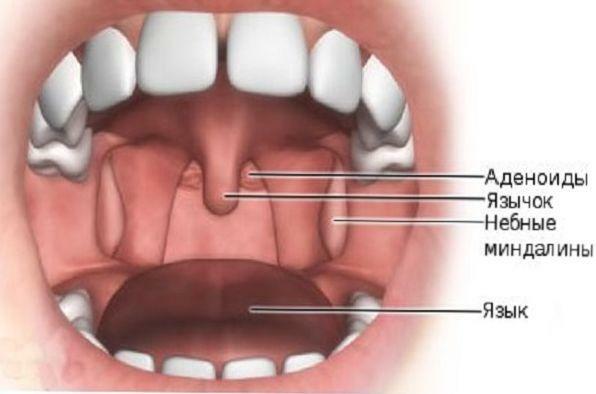
Adenoids
Attention! Consequence of adenoids - memory impairment, reduction of cognitive abilities, fast fatigue, headache, heart and vascular problems, apnea( respiratory arrest in sleep) and snoring.
There are 3 degrees of illness:
- The patient breathes freely during the day, and at night - only through the mouth. A course of conservative treatment( without surgery) can be successful.
- The patient is always easier to breathe with his mouth than with the nose, he snores in a dream. Approach to treatment is possible and conservative, and operational, but recommended removal.
- The patient can not breathe at all. At this stage of the disease, unlike the previous ones, surgery to remove the nasopharyngeal tonsil is the only way to get rid of the disease.
Degrees of adenoids
Adenoids complicate life even from the aesthetic point: the runny nose itself is an unattractive sight, the "bonus" to it is the nasal voice. A constantly open mouth - the threat of an incorrect bite and deformation of the face. The first step to solving the problem is the examination with an otolaryngologist.
At-risk groups
It is especially recommended to undergo an examination with a doctor-otolaryngologist in such categories of adult patients:
- to those who had adenoids in their childhood, regardless of whether they were removed or not( the disease may return - due to genetic predisposition, frequent colds or poor removal);
- to those who suffered from a protracted severe runny nose( the amygdala begins to grow in response to a threat to the body, protecting against infection);
- to those with nasal breathing difficulties;
- to those who suffer from any allergies;
- for those with bad or decreasing hearing.

Enlarged adenoid closes the eustachian tube
Take the risk group? Do not delay the visit to the doctor, in order to improve the quality of life as soon as possible and more effectively, getting rid of a whole range of problems.
What examinations will have to pass
The diagnosis of adenoids is based on clinical data, supported by the results of computed tomography of the nasal sinuses, biopsies and endoscopy.
- Computer tomography lasts a few seconds. Radiologist fixes the patient's head in the required position and takes a picture. Modern fluoroscopic equipment makes it possible to make the procedure harmless due to low radiation load. Before the procedure, you may be asked to remove a hearing aid, glasses, jewelry and removable dentures. Pregnant women should not take tomography.
- Endoscopy is performed under local anesthesia to eliminate feelings of discomfort. In the nasopharynx of the patient, an endoscope is inserted, through which the doctor looks at the tonsils. However, a simple examination is not enough, because in the nasopharynx may be different education.
- A biopsy is an analysis of a small piece of overgrown tissue. Since the patient is under local anesthesia, he will not feel pain. After a histological examination, a specialist can tell exactly which problem will have to work.
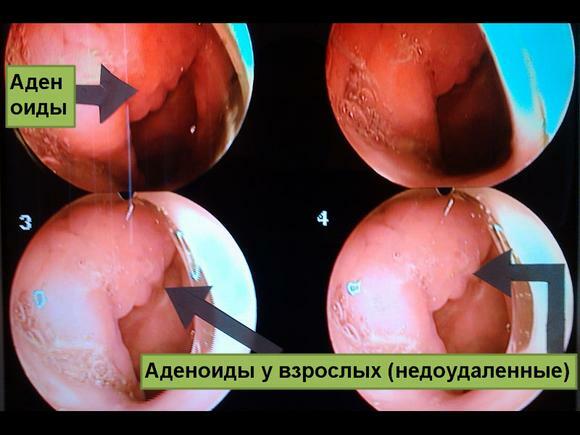
Adenoids in adults
If the tissue is really adenoid, the patient is referred to an otolaryngologist for treatment.
Treatment without surgery
Conservative treatment in adulthood is chosen in cases when the operation is contraindicated for various reasons.
If necessary, a doctor can prescribe:
- physiotherapy( inhalation, magnetic, laser therapy, UHF heating);
- hormonal nasal drops( Nazonex, Fliksonase, Avamis);
- homeopathic remedies( Thuya, Agrafis nutans, Calcaria phosphor, Schiessler's Salt);
- antibiotics if there is an inflammatory process( Supraks, Cefspan, Amoxiclav).
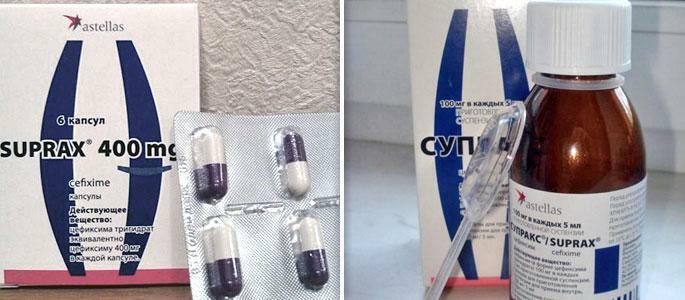
Preparation Supraks
For rinsing the nasopharynx, you can use:
- infusion of field horsetail( 1 tsp horsetail per cup of boiling water);
- decoction of oak bark, broth of chamomile( 5 g of bark to a glass of water);
- infusion of St. John's wort( 5 g of herb per glass of water);
- sea salt( 1/2 tsp per glass of water);
- rotokan or green tea( 1 teaspoon per glass of water).
This type of treatment can relieve symptoms, but will not eliminate the underlying problem. Therefore, adult patients, as a rule, recommend prompt removal of the amygdala.
Surgery to remove adenoids

Removal of adenoids with laser
If you want to get rid of adenoids quickly and reliably, it is worth stopping at a surgical procedure. Now operations have nothing to do with those that were done before the advent of modern techniques:
- Mandatory Anesthesia. Now, during the removal of adenoids, anesthesia is mandatory. This is justified, since during surgery a person can experience fear, scream, break out. This interferes with the doctor and hurts the patient. Therefore, surgical intervention occurs with general anesthesia( in some cases, contraindications of the general - under local).
- Constant surveillance through an endoscope. A small chamber, inserted through the mouth or nose of the patient, allows the doctor to clearly see what his manipulations lead to. This makes it possible to clean out the entire adenoid tissue without affecting other organs."Blind" surgery led to a large number of relapses( up to 62%).
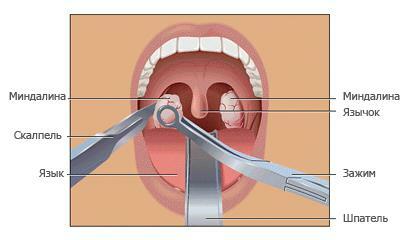
Surgical removal of adenoids
Before the operation, the patient undergoes a test, which includes blood and urine tests, as well as ECG.
Warning! Before operation it is impossible to drink and eat!
Before operation from 18.00 it is recommended to eat nothing, and in the morning you can not drink, including water. Do not be afraid of surgery - it is painless and highly effective, the patient does not experience discomfort, as it was before.
Methods for removal of adenoids
Nasopharyngeal tonsil can be removed in several ways, the choice of method remains with the doctor. It determines the optimal way to remove adenoids( adenotomy).
| Method for removing | with | tools Radio waves | laser Shaver | |
|---|---|---|---|---|
| Equipment | Becken's adenot | Surgitron. Video Endoscope | Laser. Video Endoscope | Microdeveloper. Video Endoscope |
| Anesthesia | Local | General, local | General, local | General, local |
| Advantages of | Outpatient conditions. Self-Stopping of bleeding | Minimum risk of blood loss. No bleeding after surgery | Bloodless removal of | Mucous remains intact. The adenoid is removed promptly and without residue. Bloodless and incision-free removal. Virtually no recurrence of |
| Disadvantages of | The operation is performed blindly - a relapse due to not completely removed adenoid tissue | - | The operation time is increased. Healthy tissues can be heated by laser | - |
After surgery, the adult patient remains in the hospital for up to 3 days under medical supervision.
Video - Removal of adenoids
Rehabilitation period
After discharge from the clinic, it is necessary to carry out a set of restorative and restorative measures, which the doctor recommended.
Note! After the intervention, complications are possible, the most frequent of them is bleeding. It can begin in the first 2-3 hours after adenotomy. The temperature may also rise to 37.5-38 ° C.These complications disappear after a short time.
For 4 weeks after adenotomy:
- Abstain from significant physical exertion( power sports, running, lifting weights).
- Do not take hot showers or baths.
- Do not go to the solarium and bath.
- Change the diet - until the wound is healed( 3-10 days after the operation), do not eat spicy, hot, salty, rough, hard food. It is best to temporarily switch to juices, soups, mashed potatoes, milk, broths, cereals, soft cheese, pâtés.
To prevent lymphoid tissue from growing afterwards, it is necessary:
- total body hardening;
- breathing exercises;
- reception of vitamins;
- healthy nutrition( meat, fruits, vegetables, fish, confine flour and spicy);
- walking in the fresh air;
- doing sports;
- protection against overheating and freezing( correct selection of clothes for different seasons);
- supervision by a doctor, observance of his prescriptions;
- timely correct treatment of ARVI and influenza;
- disease prevention.
By observing these rules, you not only prevent the re-growth of tissues in the nasopharynx, but also improve the quality of life in general.

